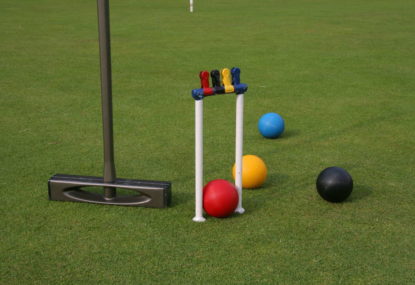JackJumpers' NBL title was special - but where does it sit among Tasmania’s top ten sporting moments?
It’s a pretty good time to be a Tasmanian sports fan right now. After years in the sporting wilderness with not much to celebrate,…

There are long-recognised hazards when playing croquet, including the rules. You play even if it rains, there are differences between regulations in association croquet, gold croquet, richochet, and other variations.
The afternoon tea is too good. Instead of keeping your head down as the shot is played, you follow your nose towards the scones. Some people believe you use a flamingo as your mallet, instead of carbon fibre, brass or wood.
Choosing a new mallet among the variables of carbon fibre, brass or wood is a difficult task, as is finding a new home for the flamingo.
Double-tap anxiety cannot be underestimated, and changing your grip, before losing it, is a concern. Then there is the danger of becoming, unintentionally, the best player on your opponent’s team.
In recent weeks a new hazard has also been seen: Billy the Kid.
None of these hazards keep croquet players from taking to the court. In part this is because croquet combines the elegance of a game several hundred years old and a modern tactical brutality rarely seen in polite sporting society.
Should you wish to challenge yourself, your opponent and fate, play croquet.
It was previously known as lawn billiards, but so much has evolved. My first mallet was a reworked railway sleeper with a broom handle attached, in homage I think to both modes of transport.
It worked very well, hitting the ball with an echoing thwack even while I was working out my grip between Solomon and the Irish.
It was very good to take up a sport in which you need to know where your knuckles are. On the television recently a lad of France placed his knuckles on Richie McCaw’s face in slow motion a few times. Not how we play in our local derby.
The local club has been at the same site for more than 80 years. During that time it has attracted tree roots which, like Douglas Bader (didn’t he play golf off five?), seem to be both reaching for the sky and heading back to earth.
A croquet ball struck true between hoop one and hoop two shall roll, and wheel, and tilt and roll again, chasing both warp and weft on its way over the grass.
Yet this is the charm of the court, where not only dew point make the green sometimes run fast and sometimes run slow but offers variables in topography and miniature altitude at critical points. Flat, even ground is wonderful, but the chance of a twist and a turn on the lawn is an unexpected delight.
Variables, vary. And then so must technique. A skill in croquet is to play your ball through a hoop for which the gap either side is very narrow. There is great precision. Angles are critical: acute and obtuse becoming psychological characteristics of the game rather than geometric descriptions because you are trying to play your next shot as the first in a sequence, to take you to and through the next hoop and more.
Your opponent has other ideas. While the ball may lie static, the variables are many. And then they change at the next shot. Think, think again. No wonder I need jam and double cream on top of my scone.
There is cross pollination of other sports with croquet. Lawn tennis was first taken up on croquet courts, as Wimbledon still highlights. I’d happily play doubles golf croquet with Roger Federer, as he seems to be able to think before hitting the ball. But other professional tennis players perhaps should not be given a mallet – and it’s not as if it rhymes with wallet.
Occasionally a golf ball lands on the local club’s lawn. Cry fore and let slip it seems to be. The golfers are surprised to have the white croquet ball returned to them, as the golf ball goes careening through our hoops.
Fortunately with only one mallet in our bag, there is no need to rake the bunkers afterwards.
Less frequently a Gilbert arrives from the adjoining rugby field, but the returned croquet ball is easy to pass right between the posts.
Croquet may have other similarities with rugby, but this needs closer scrutiny: at the end of last season, rugby players unclothed were seen over the dead-ball line. This was glimpsed off Green No.2 and from there, there seemed shortened garden-variety mallets.
In croquet, players must go the distance; even jumping through hoops. Needless to say the mallet heads are peripherally weighted.
Both New Zealand and Australian ingenuity has recently gone into changes made – partly through technology – to hard plastic milled balls, polished metal hoops and the workings of a mallet.
Science has therefore added greatly to the game. But, with all the other variables found in the surface, the angles, the changes, the mentality, the ‘chance’ in croquet still remains the great variable. The seductive haphazard.